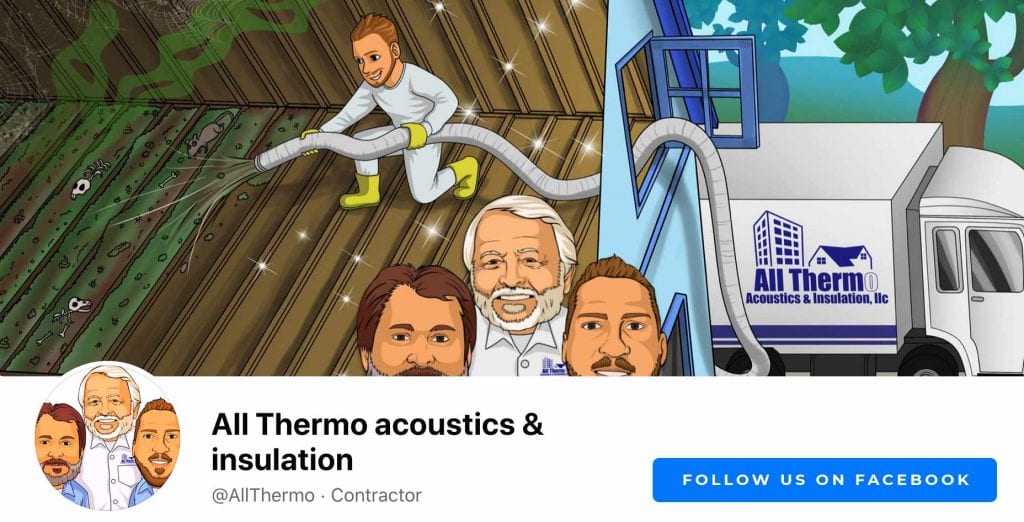Sweating AC Ducts
EXCELLENTTrustindex verifies that the original source of the review is Google. Great customer service and workmanship from the quote to the execution of the job. There is obvious pride in this family owned business.Trustindex verifies that the original source of the review is Google. Very satisfied, professional, clean, and quick… my house is already getting cool.Trustindex verifies that the original source of the review is Google. They are punctual, professional, and thorough. I appreciate them being courteous and responsive to any questions or concerns I had throughout the process. Their crew worked quickly and efficiently. Would recommend to anyone!Trustindex verifies that the original source of the review is Google. Couldn’t be happier with the work done by Jason/Christian and their team. Excellent communication and very professional.Trustindex verifies that the original source of the review is Google. Excellent treatment and care of my property while blowing in the insulation. The crew that did the job were spot on as well as the customer service. Thanks All ThermoTrustindex verifies that the original source of the review is Google. Absolutely a wonderful company to do business with. I was very impressed with the employees and their professionalism. I would hire All Thermo Acoustics and Insulation again. If you are in need of attic insulation don't hesitate hire All Thermo. Great company. Thanks guys.Trustindex verifies that the original source of the review is Google. Trustindex verifies that the original source of the review is Google. Very professional. Was not the cheapest quote I received but the work done you get what you pay for. Very happy to finally have insulation in my home. Would recommend 100%.Trustindex verifies that the original source of the review is Google. Great experience working with All Thermo!Trustindex verifies that the original source of the review is Google. All Thermo did an exceptional job remediating a long-standing issue with humidity in my home - they are a highly professional team that combine wisdom and expertise with excellent work ethics. They are experts in the Pasten Effect, and deploy cutting edge technology to address this and other sequelae of elevated humidity such as we experience in South Florida. My recommendation is 5/5 and unqualified. .
Sweating AC Ducts: Causes, Symptoms, & Fix for Condensation in South Florida
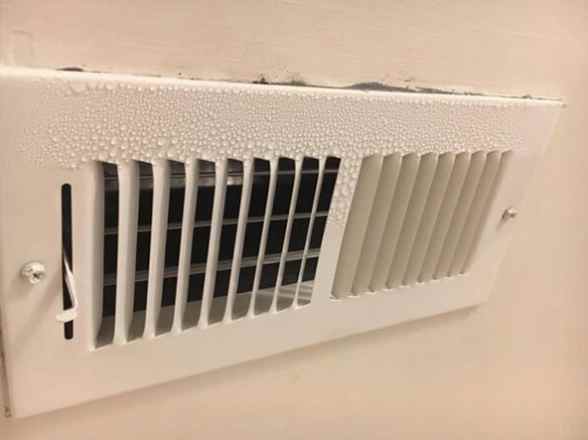
What are air conditioning ducts (AC Ductwork)
Air conditioning ducts are a network of ducts that distribute conditioned air from a central air conditioning system to a home’s living spaces. They are crucial to the heating and cooling a home, as they transfer air from the air vents to the main cooling or heating unit and back. Ducts can be made of sheet metal, fiberglass, or fiberboard, and they must be adequately insulated to prevent condensation or sweating. Sweating AC ducts can lead to wet ceilings, warped floors, and possible mold and musty odors. Additionally, clogged or leaky ducts can impact an air conditioner’s performance and cause dehumidifying problems. All Thermo has been fixing AC ductwork and insulation for over 40 years.
What are the causes of sweating AC ducts and condensation on air vents?
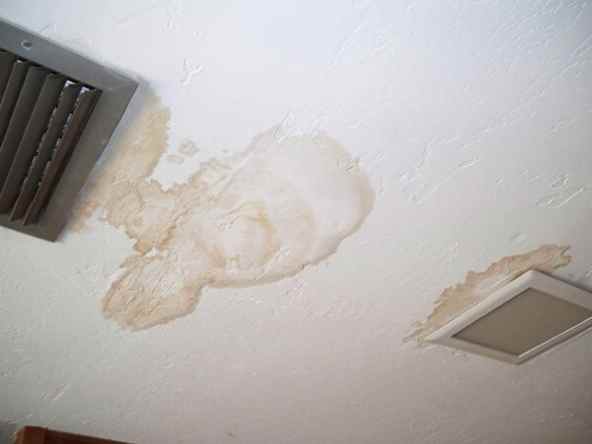
1. Excessive humidity and Dew Point
Excessive indoor humidity can lead to sweating air conditioning ducts, which can cause damage to your home and harm your health. One of the main causes of sweating AC ducts is ductwork sweating, which adds excess moisture to the air inside the house, making it far less comfortable. Additionally, plumbing emergencies, indoor flooding, and air-drying clothes indoors can substantially elevate the humidity in the short term. Higher humidity indoors increases the risk of condensation on your air ducts, especially when running your air conditioner. The higher the moisture in your house, the higher the risk for condensation build-up in your ductwork. It is crucial to address this issue to prevent damage to your home and potential health risks.
2. Leaky ducts
Leaky ducts are one of the primary causes of sweating air conditioning ducts. When the seals in the ductwork wear out, air leaks occur, which can impact the performance of the air conditioner and cause condensation on the AC ducts. The following are the causes of leaky ducts that lead to condensation and sweating:
- Poor insulation: Even if the ductwork has insulation around it, cold air leaking into the insulation can affect its performance. This can intensify ductwork sweating, making the insulation less effective.
- Air leakage: Air leaks prevent the efficient circulation of air, which can also intensify ductwork sweating. A duct system must be free of air leaks and possess the correct amount of insulation to prevent condensation build-up on ductwork.
In conclusion, leaky ducts are a significant contributor to sweating air conditioning ducts. Poor insulation and air leakage are the primary causes of sweating AC ducts. It is essential to address these issues by assessing the insulation and airflow and repairing or replacing the ductwork as needed. AC duct sealing with mastic. By doing so, you can prevent condensation build-up on ductwork, water damage, and mold or mildew from forming in areas surrounding the duct itself.
3. Poor air conditioning system
Sweating air conditioning ducts can be a sign of a poorly functioning air conditioning system. It is important to identify the causes of sweating ducts to ensure the system is running efficiently and to prevent further damage. There are several causes of sweating air conditioning ducts due to a poor air conditioning system. Firstly, poor insulation or air leakage in the duct system can cause condensation. Secondly, dirty air filters and blocked ducts can restrict airflow, leading to excessive condensation. Thirdly, ductwork sweating can be caused by excessive humidity in the house or warm air in the attic. Lastly, duct leakage can reduce the efficiency of the air conditioning unit, leading to ductwork sweating. To prevent sweating air conditioning ducts, it is crucial to maintain the air conditioning system regularly, keep all vents open, and ensure proper insulation and airflow in the duct system. By addressing these issues, you can improve the performance of your air conditioning system and avoid costly repairs in the future.
4. Uncontrolled airflow
Uncontrolled airflow can cause sweating air conditioning ducts, leading to a host of problems in your home. When the airflow through the ducts is restricted, the cold air produced by the AC system is unable to circulate effectively. As a result, the temperature inside the ducts drops, causing moisture in the air to condense on the duct walls. This condensation can lead to mold growth, damage to your ceiling, and reduced insulation effectiveness. Additionally, uncontrolled airflow can be exacerbated by blocked or dirty air filters, leaky or poorly insulated ducts, and excessive humidity levels in your home. To prevent sweating ducts, it is crucial to control airflow by ensuring that all vents are open and unblocked, filters are clean, ducts are adequately insulated and sealed, and humidity levels are kept low.
5. Insufficient attic insulation
Insufficient attic insulation can cause sweating air conditioning ducts in multiple ways. Firstly, poor insulation allows for attic temperatures to rise, which in turn can cause the AC system to produce more water vapor. Secondly, if the insulation has cracks or tears, warm air can seep in and affect the temperature of the insulation. Thirdly, inadequate insulation or overly humid crawlspaces can cause condensation to form on the outside of the insulation, eventually dripping onto the ducts and compressing the fibers together, reducing the insulation’s R-value. As a result, the insulation becomes less effective at regulating temperatures inside the home, leading to sweating air conditioning ducts.
6. HVAC System Problems
Sweating AC ducts can be a sign of an underlying problem with your HVAC system. If ignored, it can lead to various issues such as mold growth, damage to the walls and ceiling, and poor air quality. There are several factors that contribute to sweating ducts, including poor insulation, clogged ducts, and high humidity levels. In this section, we will discuss the common causes of sweating ducts in an ordered list and provide a detailed explanation of how each factor contributes to the problem. We will also explain the symptoms of sweating ducts and how to identify them. Finally, we will summarize the causes and symptoms of sweating ducts.
7. Climates
There are several climates that can lead to sweating air conditioning ducts. These include high humidity levels, especially in unconditioned spaces like attics, where temperatures can reach high levels during the day. When the relative humidity reaches 100%, moisture condenses and forms summer dew points or “sweat” on surfaces. This can also happen on cool, reflective surfaces of the ductwork. Additionally, the emissivity of surfaces plays a role in duct sweating, as dark and opaque surfaces absorb more radiant heat and emit more heat, while reflective surfaces absorb less heat and stay cooler. Therefore, climates with high levels of radiant heat can also contribute to sweating air conditioning ducts.
8. Aging Air Conditioners
Air conditioning ducts can sweat due to various reasons, and aging air conditioners are often the culprit. Poorly maintained air conditioners can cause ductwork sweating, resulting in reduced efficiency and higher energy bills. Aging air conditioners can lead to clogged filters, worn-out insulation, and faulty thermostats, which can cause excessive moisture buildup in the air. Additionally, blocked or leaky ducts can reduce the efficiency of the air conditioning unit, leading to a rise in humidity levels and, in turn, causing ductwork sweating. Regular maintenance of air conditioning units is crucial to prevent sweating ducts and maintain optimal efficiency. By replacing air filters, repairing leaks, and upgrading insulation, homeowners can keep their air conditioning units running smoothly and avoid costly repairs in the long run.
9. Poor ductwork maintenance
What are the symptoms of sweating air conditioning ducts?
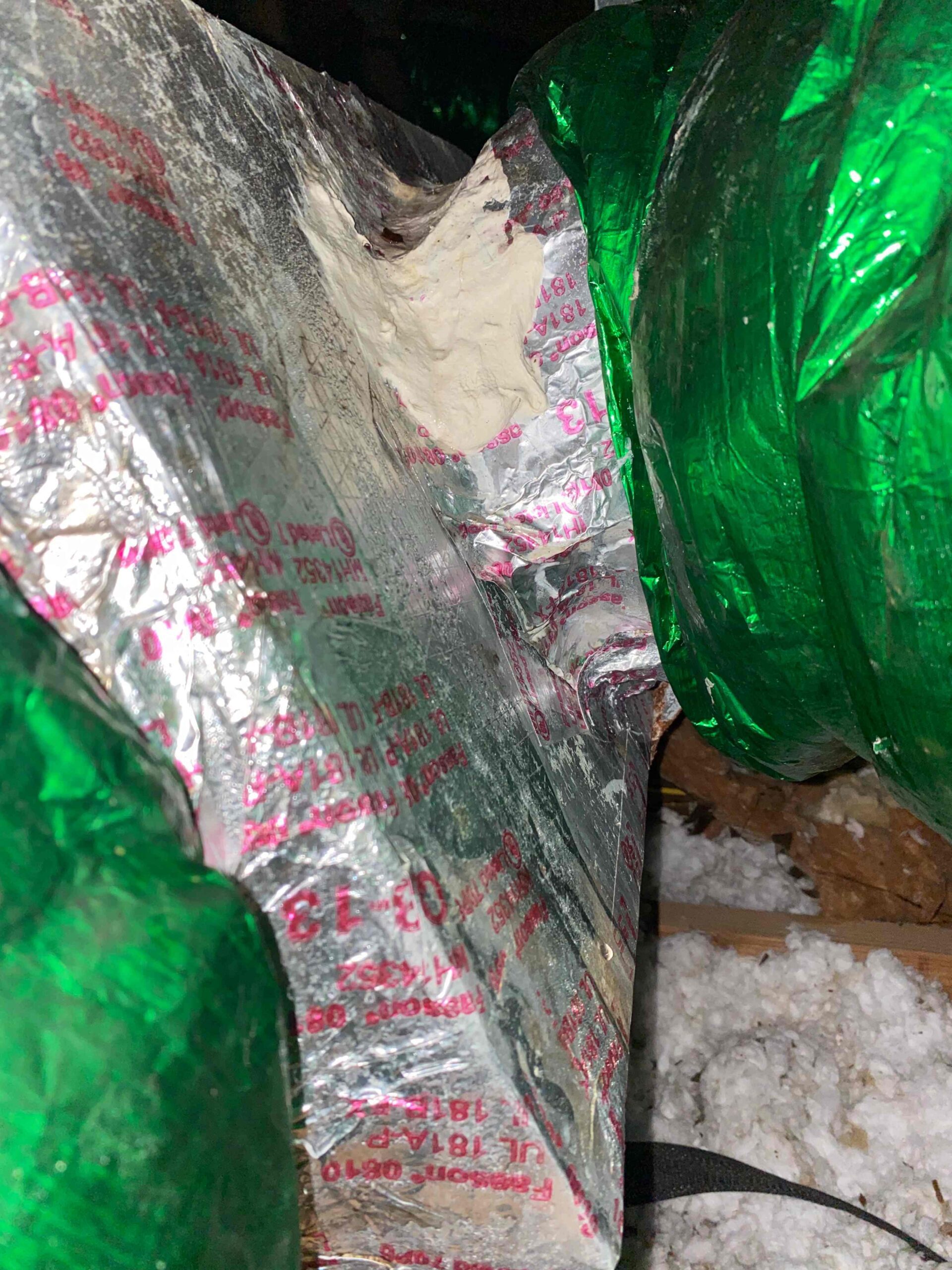
1. Moisture Buildup Around Air Conditioning Ducts
Moisture buildup around air conditioning ducts can lead to condensation, which can cause a range of issues in your home. It is important to recognize the symptoms of sweating AC ducts to prevent further damage. Below is an unordered list of common symptoms that may indicate ductwork sweating:
- Water damage
- Mold or mildew growth
- Foul smells
- Weak airflow
- Strange noises
- Increased asthma or allergy symptoms
If you notice any of these symptoms, it is crucial to seek a fix for the condensation to avoid further problems. Proper maintenance and sealing of your ductwork can help prevent moisture buildup and ensure good air circulation in your home.
2. Uncomfortable Temperature Inside Home
Sweating air conditioning ducts occur when the temperature inside the home is too high, and the humidity level is also high. This can cause discomfort in the home, and homeowners may experience several symptoms. Firstly, the air inside the home may feel stuffy and humid, making it difficult to breathe. This can cause respiratory problems for people with allergies or asthma. Secondly, the excess moisture in the air can cause damage to wood floors, wallpaper, and paint, resulting in costly repairs. Thirdly, the bad odor caused by the excess moisture can make the home unpleasant to live in. Fourthly, the high humidity can cause discomfort, making it difficult to sleep or relax. Lastly, sweating air conditioning ducts can reduce the efficiency of the HVAC system, leading to higher energy bills. To minimize the symptoms of uncomfortable temperature inside the home caused by sweating air conditioning ducts, homeowners should keep the indoor humidity level low. They can achieve this by properly insulating their attic, sealing any leaks, and using dehumidifiers. It is important to fix sweating air conditioning ducts to improve home comfort, reduce repair costs, and lower energy bills.
3. Mold and Mildew Growth Around AC Ducts
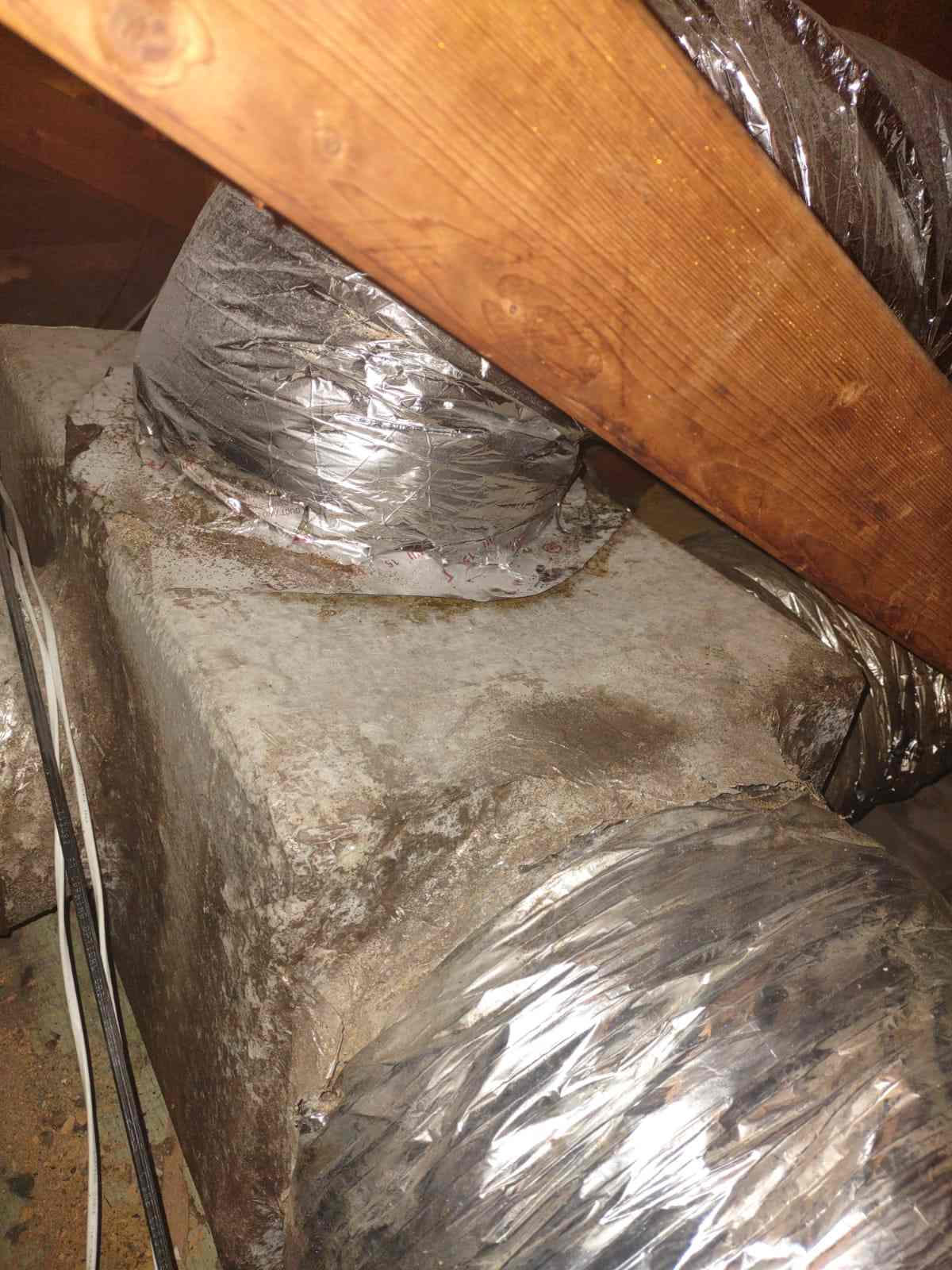
Excessive moisture in air conditioning ducts can lead to mold and mildew growth, which can cause damage to structural components around the home and trigger allergies and other health issues. Here are the steps to prevent mold and mildew growth around air conditioning ducts due to sweating:
- Keep an eye on the situation: Occasional condensation on an air conditioning duct is not a problem. However, it is important to monitor the situation because persistent ductwork sweating can lead to water damage and mold growth.
- Regular maintenance: Regular maintenance of air conditioning systems is essential to prevent moisture buildup in ducts. It is recommended to hire an HVAC expert to perform regular maintenance checks to ensure that there is no moisture in the AC ducts.
- Check for leaks: If you notice any leaks from the vents, hire an HVAC expert soon to take a look.
- Check condensate drip pan: Check the condensate drip pan regularly to ensure that there is no excessive amount of water in the air ducts.
- Check humidity levels: Check the humidity levels in your attic regularly, as excessive sweating of air conditioning ducts can increase humidity levels in the attic, leading to mildew and mold growth.
It is important to take action to prevent mold and mildew growth in air conditioning ducts to maintain a healthy indoor environment. If left unchecked, mold and mildew growth can cause extensive damage to your home and lead to health issues. Therefore, it is essential to be proactive in preventing moisture buildup in air conditioning ducts and to take prompt action if you notice any signs of mold or mildew growth. Regular maintenance checks and monitoring the situation can go a long way in preventing mold and mildew growth and ensuring a healthy indoor environment.
4. Leaking Ducts That Cause Ceiling Damage
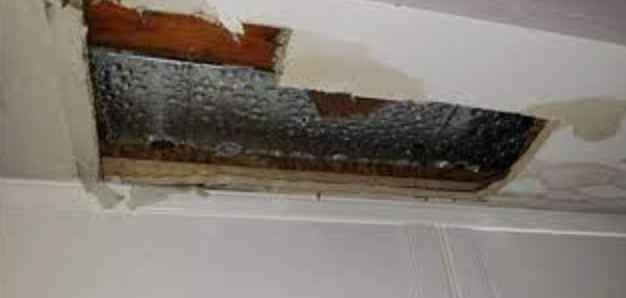
Leaky air conditioning ducts can cause serious damage to ceilings if left unattended. Symptoms of leaking ducts include water stains on the ceiling, mold growth, and musty odors. These symptoms can lead to weakened ceiling structure and electrical hazards. Water stains on the ceiling are a clear sign of a leaky duct, and if not addressed promptly, can lead to rotting drywall and even ceiling collapse. Mold growth and musty odors are also common symptoms of leaking ducts, which can pose health risks to individuals with allergies or respiratory issues. Moreover, leaking ducts can weaken the ceiling structure and create electrical hazards if water comes into contact with electrical wiring. Therefore, it is crucial to address leaking ducts promptly to prevent further damage to the ceiling and potential safety hazards.
5. Air Conditioning Unit That No Longer Works Properly
The symptoms of sweating air conditioning ducts include reduced airflow, a noisy A/C system, a sudden increase in condensation on the exterior of the A/C unit, inconsistent temperatures inside the house, foul odors coming through the air vents, and larger electric bills than in previous years. These issues can be caused by several factors, such as a broken A/C compressor, a broken fan inside the unit, internal temperature issues, or pressure leaks. Sweating air conditioning ducts can lead to condensation build-up on the ductwork, and this can be caused by poor insulation, excessive moisture in the air, dirty air filters, and blocked ducts. If not addressed promptly, sweating air conditioning ducts can lead to improper functioning of the unit, causing condensation build-up on the ductwork and further damage to the air conditioning unit. Therefore, it is important to have an HVAC professional diagnose the cause of sweating air conditioning ducts and fix the problem as soon as possible.
6. Increased Energy Bills
Sweating air conditioning ducts can lead to increased energy bills due to multiple factors. Condensation build-up in the air ducts can drip onto the insulating materials, saturating them with water and reducing their R-value. As a result, the insulation’s ability to insulate the home decreases, leading to higher energy bills. Additionally, dirty HVAC filters can restrict airflow, compromising the AC’s cooling efficiency and dehumidifying abilities. This can lead to excess moisture in the air, causing indoor humidity problems and further increasing energy bills. Proper maintenance, including regular filter replacement, duct sealing and insulation, and upgrading insulation, can help prevent sweating ducts and save money on energy bills.
7. Odors and Dust Allergies
Sweating air conditioning ducts can lead to a variety of unpleasant odors in the home, including musty or moldy smells. These odors are often caused by the growth of mold and mildew in the moist environment created by the sweating ducts. For individuals with dust allergies, sweating ducts can exacerbate symptoms such as sneezing, coughing, and itchy eyes. The excess moisture in the air can also cause dust particles to stick together and become heavier, making them more difficult to filter out of the air. It is important to address sweating ducts to improve indoor air quality and alleviate allergy symptoms. Regular maintenance and cleaning of ductwork by a professional HVAC contractor can help prevent these issues.
8. Increased Humidity in the Home
When air conditioning ducts sweat, excess moisture is added to the air inside the home, leading to increased humidity levels. High indoor humidity can cause a range of physical symptoms and structural damages, including discomfort, bad odors, and costly repairs. Wood floors, wallpaper, and paint can be damaged, while metal ductwork may rust and corrode. The longer water sits, the higher the risk of mildew and mold growth, which can pose severe health risks. It is important to identify and fix the root cause of sweating ducts to prevent further damage. Solutions may include air sealing, insulation, ventilation, and/or dehumidification.
9. Damp Walls and Ceilings
Sweating air conditioning ducts can lead to damp walls and ceilings, which can cause several symptoms. Firstly, prolonged moisture can cause corrosion or decay in building materials, leading to the loss of thermal capacity in your home. Secondly, high indoor humidity can cause damage to wood floors, wallpaper, and paint, and can also cause bad odors. Thirdly, dripping condensation may lead to a ceiling leak, which not only looks bad but also rots drywall and can cause your ceiling to collapse over time. Fourthly, mold growth is a significant concern, as mold thrives in wet, humid areas, and can pose severe health risks, especially for people with allergies and compromised immune systems. Lastly, excessive ductwork sweating can lead to water dripping from your ceilings and leave stains, which can be costly to repair. In summary, sweating air conditioning ducts can lead to several symptoms of damp walls and ceilings, which can compromise your home’s structure and pose health risks.
How to fix sweating AC ducts and Condensation on AC grills
Step 1: Reduce the humidity level
Reducing humidity levels is the first step in fixing sweating air conditioning ducts. High humidity levels in your home can lead to condensation on your air ducts, resulting in dripping water, mold growth, and even structural damage. Therefore, it is essential to reduce the humidity levels in your home to prevent these issues.
There are several practical ways to reduce humidity levels in your home. One of the most effective ways is to use a dehumidifier. A dehumidifier is a device that removes excess moisture from the air, making it drier. To use a dehumidifier, follow these steps:
- Choose the right size dehumidifier for your home. Check the manufacturer’s instructions for guidance on the appropriate size for your home.
- Place the dehumidifier in a central location in your home. Make sure it is not obstructed by any furniture or other objects.
- Turn on the dehumidifier and set the humidity level to between 40% and 60%. This is the recommended range for both comfort and health.
- Check the dehumidifier’s reservoir frequently and dump the collected water so it does not overflow.
Apart from using a dehumidifier, you can also reduce humidity levels in your home by fixing leaks in pipes and roofs. Leaks can introduce excess moisture into your home, which can contribute to high humidity levels. To fix leaks, follow these steps:
- Identify the source of the leak. Check for water stains on walls and ceilings, drips, or wet spots.
- Fix the leak as soon as possible. If you are unable to fix it yourself, call a professional plumber or roofer.
In addition to fixing leaks, using exhaust fans can also help reduce humidity levels in your home. Exhaust fans are designed to remove moisture from the air, which can be particularly helpful in areas like the bathroom and kitchen. To use exhaust fans, follow these steps:
- Turn on the exhaust fan in the bathroom or kitchen before showering or cooking.
- Leave the fan on for at least 15-20 minutes after you are done showering or cooking.
- Clean the exhaust fan regularly to ensure it is functioning properly.
In conclusion, reducing humidity levels is crucial in fixing sweating air conditioning ducts. Using a dehumidifier, fixing leaks in pipes and roofs, and using exhaust fans. By implementing these methods, you can prevent condensation on your air ducts, protect your home from damage, and promote a healthy and comfortable indoor environment.
Step 3: Keep your air filters clean
Dirty air filters restrict airflow in your HVAC system, which can cause air conditioning ducts to sweat. This not only compromises your AC’s cooling efficiency but also its dehumidifying abilities. The good news is that you can prevent this issue by keeping your air filters clean. To do so, replace your air filters every three months, even if you don’t see condensation on AC ducts. If you have pets, change them more often as their fur can clog up filters. If someone in your household smokes, ban indoor smoking or change the filters more frequently. When Seattle’s air quality drops, change filters more often too. It’s also essential to have a professional HVAC technician clean your ductwork every three to five years to ensure proper airflow and improve your home’s indoor air quality. By following these steps, you can keep your air filters clean and prevent sweaty air conditioning ducts.
Step 5: Keep an eye out for sweating AC ducts
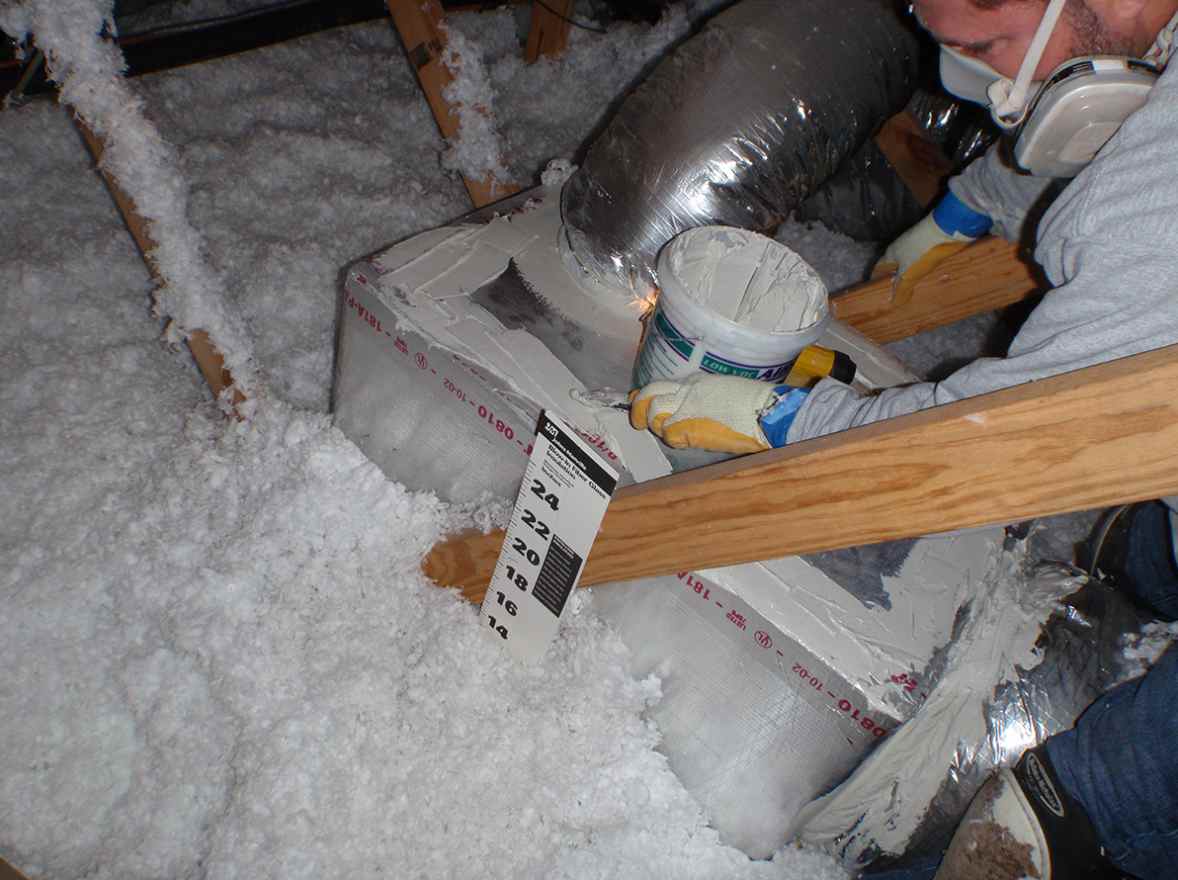
It’s essential to check for leaking ducts if you want to fix sweating air conditioning ducts. Leaking ducts can impact the performance of your air conditioner and cause condensation on AC ducts. Here is a step-by-step guide on how to check for leaking ducts:
- First, turn on your HVAC system and wait for it to start circulating air.
- Go to each air vent and check for any air escaping around the edges of the duct. You can feel for air escaping by placing your hand near the edges of the vent.
- If you feel air escaping, you may have a leak in your ductwork. To confirm, use a pressure gauge to measure the air pressure inside the duct. If the pressure is lower than it should be, you likely have a leak.
- Check all the joints and connections in your ductwork for signs of leakage, such as visible gaps or cracks.
- If you find a leak, mark the location so you can easily find it later.
Once you have identified any leaking ducts, it’s important to repair them as soon as possible. The more cold air that seeps out, the more condensation will form on your ducts. You can either seal the leak yourself or hire a professional to do it for you. Sealing leaking ducts not only prevents sweating air conditioning ducts, but it also improves the efficiency of your HVAC system. By fixing any leaks, you will be able to save money on your energy bills and increase the lifespan of your air conditioning system. Remember to conduct regular inspections of your ductwork to prevent any potential problems from turning into bigger issues.
Step 6: Air sealing your home attic space
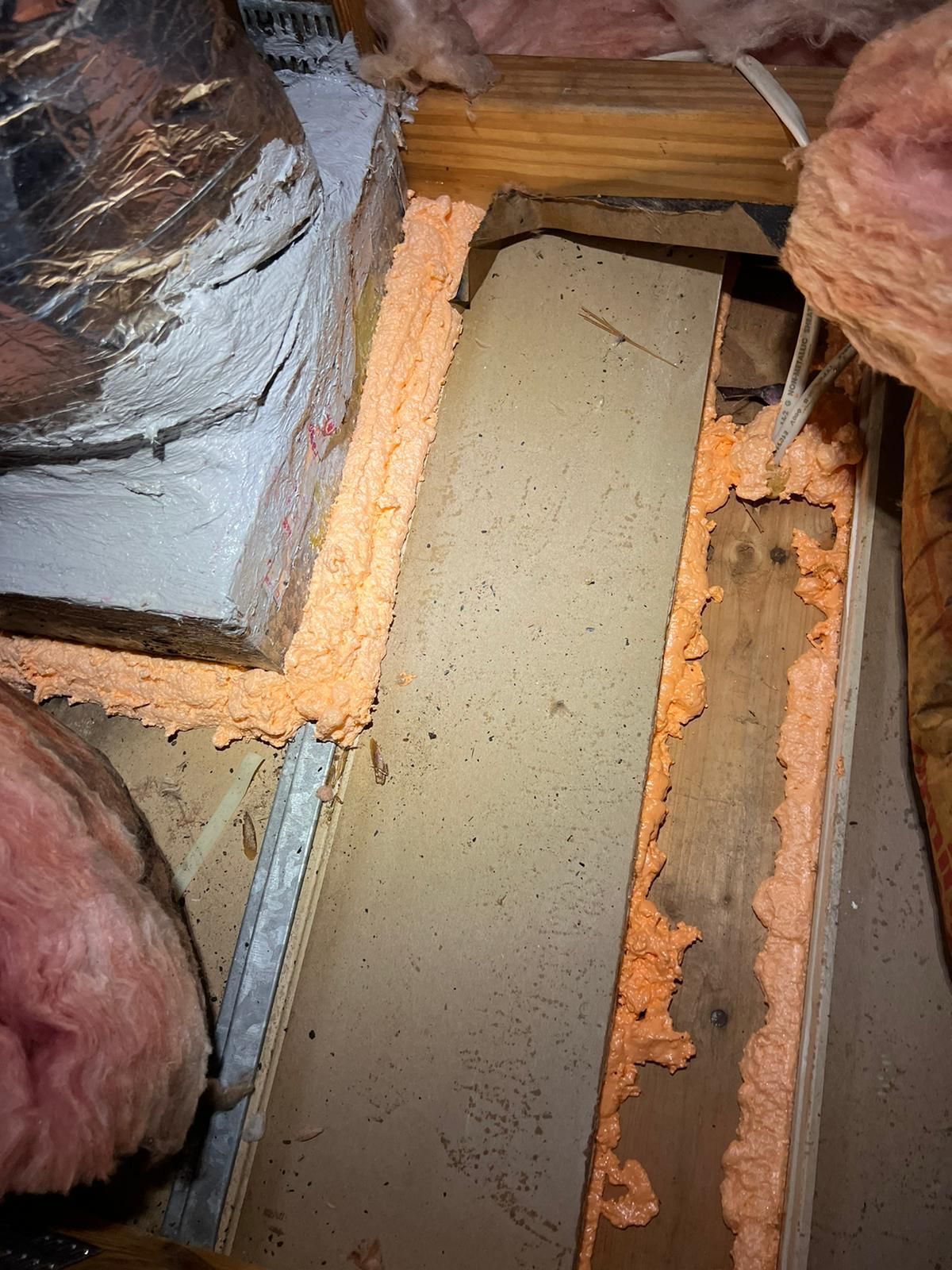
Air sealing your home attic space is an essential step towards reducing condensation on your air conditioning ducts. Air leaks in your attic can lead to the entry of humid air, causing the moisture to accumulate on your ducts, leading to sweating and ultimately water damage. Here are the steps to follow when air sealing your home attic space:
- Identify air leaks: Start by identifying the air leaks in your attic space. Look for gaps, cracks, and holes in your attic walls, ceilings, and floors that could be letting in outside air.
- Seal openings with foam board and caulk: Once you have identified the air leaks, use foam board and caulk to seal them. Foam board can be used to fill larger gaps, while caulk is ideal for sealing smaller ones. Be sure to seal around pipes, wires, and ductwork as well.
- Add insulation: Adding insulation is an essential step in air sealing your attic space. Insulation helps to prevent the entry of outside air and keeps your home cool during hot weather. Look for insulation with a high R-value, which offers better protection from air leakage and performs better at blocking outside air from entering.
- Inspect and maintain your air sealing regularly: Regular inspections and maintenance of your air sealing are crucial to ensuring maximum efficiency. Check for any new air leaks and reseal them as needed. Also, replace insulation that has become damaged or wet over time.
By following these steps, you can effectively air seal your home attic space and prevent condensation on your air conditioning ducts. Sealing air leaks, sealing openings with foam board and caulk, and adding insulation are all effective ways to reduce the entry of humid air into your attic space. Regular inspection and maintenance of your air sealing will ensure maximum efficiency and help prevent future problems. Remember, a well-sealed attic can save you money on energy costs and protect your home from water damage.
Step 7: Sweating AC ducts? The best way to dry your AC ductwork is to have All Thermo diagnose and address the root cause. Call (561) 842-3336 or contact us to schedule a consultation! We’ve been fixing sweating AC ducts for over 40 years!
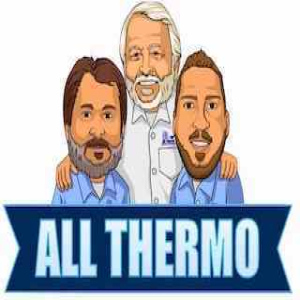
In conclusion, sweaty air conditioning ducts can be a frustrating problem to deal with, but it’s important to address the root cause to prevent further damage and maintain a healthy home environment. While there are some DIY options available, seeking professional help from All Thermo is the best choice to ensure an accurate diagnosis and effective solution. Our team of experts can assess your ductwork, identify the underlying cause of the sweating, and provide solutions such as sealing and insulating your ducts, sealing ventilation, and reducing indoor and attic humidity levels. By choosing All Thermo you can have peace of mind that your ductwork is in good hands and your home is healthy and comfortable. Don’t hesitate to contact us at (561) 842-3336 to schedule an appointment today.
FAQ: Sweating AC Ducts and Condensation Issues
1. How do I know if my AC ducts are sweating?
Sweating AC ducts can be identified by:
- Visible condensation or water droplets on duct surfaces.
- Water stains on ceilings or walls near ductwork.
- Musty odors indicating mold or mildew growth.
- Increased humidity and discomfort in your home.
2. What causes AC ducts to sweat?
Sweating AC ducts are typically caused by:
- High indoor humidity levels.
- Poorly insulated or damaged ductwork.
- Air leaks that allow warm, humid air to contact cold ducts.
- Clogged air filters restricting airflow.
- Poor attic insulation and ventilation.
3. Can sweating AC ducts cause mold growth?
Yes, persistent moisture on ducts creates an ideal environment for mold and mildew to thrive. This can lead to poor indoor air quality, respiratory issues, and damage to surrounding materials like drywall and insulation.
4. How can I reduce humidity levels in my home?
To lower humidity and prevent duct sweating:
- Use a dehumidifier to maintain indoor humidity between 40% and 60%.
- Fix any plumbing or roof leaks promptly.
- Use exhaust fans in bathrooms and kitchens to remove moisture.
- Seal any air leaks in your attic and ductwork.
5. How often should I clean or replace my HVAC air filters?
Air filters should be replaced every 1–3 months. Homes with pets, smokers, or high dust levels may need more frequent replacements to maintain proper airflow and prevent condensation issues.
6. How does poor insulation lead to sweating AC ducts?
Insufficient or damaged insulation allows warm, humid air to interact with cold ducts, causing condensation. Upgrading attic and duct insulation can regulate temperatures and reduce sweating.
7. Can I fix sweating AC ducts myself?
Some fixes, like replacing air filters or using a dehumidifier, can be DIY. However, for issues like air leaks, poor insulation, or HVAC inefficiencies, it’s best to hire a professional HVAC technician for accurate diagnosis and repairs.

Our family. Taking care of yours for over 50 years.
Follow Us on Facebook
105+ Years of Combined Experience!

